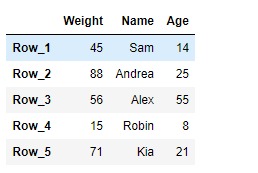Pandas DataFrame是帶有標簽軸(行和列)的二維大小可變的,可能是異構的表格數據結構。算術運算在行和列標簽上對齊。可以將其視為Series對象的dict-like容器。這是 Pandas 的主要數據結構。
Pandas DataFrame.blocks屬性是的同義詞as_blocks()函數。它本質上將幀轉換為dtype->構造器類型的字典,每個字典都具有同質dtype。
用法: DataFrame.blocks
參數:沒有
返回:字典
範例1:采用DataFrame.blocks屬性以返回包含單獨數據類型塊中的數據的字典。
# importing pandas as pd
import pandas as pd
# Creating the DataFrame
df = pd.DataFrame({'Weight':[45, 88, 56, 15, 71],
'Name':['Sam', 'Andrea', 'Alex', 'Robin', 'Kia'],
'Age':[14, 25, 55, 8, 21]})
# Create the index
index_ = ['Row_1', 'Row_2', 'Row_3', 'Row_4', 'Row_5']
# Set the index
df.index = index_
# Print the DataFrame
print(df)輸出:

現在我們將使用DataFrame.blocks屬性以返回給定 DataFrame 的塊表示形式。
# return a dictionary
result = df.blocks
# Print the result
print(result)輸出:

正如我們在輸出中看到的,DataFrame.blocks屬性已成功返回包含 DataFrame 數據的字典。同類列是同一塊中的位置。
範例2:采用DataFrame.blocks屬性以返回包含單獨數據類型塊中的數據的字典。
# importing pandas as pd
import pandas as pd
# Creating the DataFrame
df = pd.DataFrame({"A":[12, 4, 5, None, 1],
"B":[7, 2, 54, 3, None],
"C":[20, 16, 11, 3, 8],
"D":[14, 3, None, 2, 6]})
# Create the index
index_ = ['Row_1', 'Row_2', 'Row_3', 'Row_4', 'Row_5']
# Set the index
df.index = index_
# Print the DataFrame
print(df)輸出:

現在我們將使用DataFrame.blocks屬性以返回給定 DataFrame 的塊表示形式。
# return a dictionary
result = df.blocks
# Print the result
print(result)輸出:

正如我們在輸出中看到的,DataFrame.blocks屬性已成功返回包含 DataFrame 數據的字典。同類列是同一塊中的位置。
相關用法
- Python pandas.map()用法及代碼示例
- Python Pandas Series.str.len()用法及代碼示例
- Python Pandas.factorize()用法及代碼示例
- Python Pandas TimedeltaIndex.name用法及代碼示例
- Python Pandas dataframe.ne()用法及代碼示例
- Python Pandas Series.between()用法及代碼示例
- Python Pandas DataFrame.where()用法及代碼示例
- Python Pandas Series.add()用法及代碼示例
- Python Pandas.pivot_table()用法及代碼示例
- Python Pandas Series.mod()用法及代碼示例
- Python Pandas Dataframe.at[ ]用法及代碼示例
- Python Pandas Dataframe.iat[ ]用法及代碼示例
- Python Pandas.pivot()用法及代碼示例
- Python Pandas dataframe.mul()用法及代碼示例
- Python Pandas.melt()用法及代碼示例
注:本文由純淨天空篩選整理自Shubham__Ranjan大神的英文原創作品 Python | Pandas DataFrame.blocks。非經特殊聲明,原始代碼版權歸原作者所有,本譯文未經允許或授權,請勿轉載或複製。
